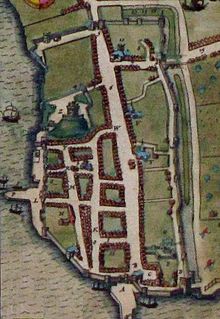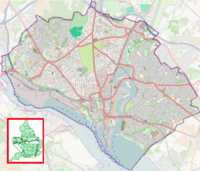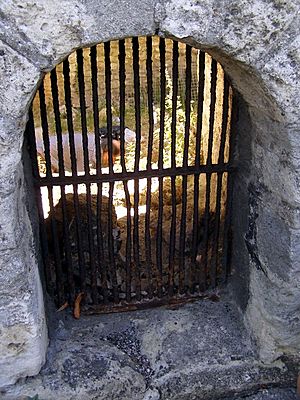Southampton Castle facts for kids
Quick facts for kids Southampton Castle |
|
|---|---|
| Hampshire, England | |

The castle portrayed by John Speed in a map of 1612
|
|
| Coordinates | 50°54′03″N 1°24′19″W / 50.9007°N 1.4054°W |
| Type | Motte and bailey, later shell keep |
| Site information | |
| Condition | Destroyed, with isolated remains |
| Site history | |
| Materials | Stone |
| Battles/wars | French raid of 1338 |
Southampton Castle was an important castle located in the town of Southampton in Hampshire, England. It was built after the Norman conquest of England and stood in the north-west part of the town. From its spot, it could look over the River Test. At first, it was a wooden motte and bailey castle.
By the late 1100s, the castle was mostly made of stone. It played a big role in the wine trade that happened through Southampton's docks. By the end of the 1200s, the castle was not in great shape. But when French raids threatened in the 1370s, King Richard II ordered a lot of rebuilding. The castle became very strong and was one of the first in England to have cannons.
The castle fell into disrepair again in the 1500s. In 1618, it was sold to people who wanted to develop the land. Over time, it was used for different things, including a large Gothic house in the early 1800s. Eventually, the site was flattened and built over. Today, only a few parts of the castle can still be seen in Southampton.
Contents
History of Southampton Castle
Building the Castle: 1000s to 1200s
Southampton Castle was first built in the late 1000s, after the Normans took over England. At that time, Southampton was a fairly large town. The royal castle was put up where a big English hall probably stood. Building the castle caused a lot of damage to nearby buildings, as space was cleared for the new fort.
Southampton was protected by water on most sides, with ditches and banks. The castle was built on high ground in the north-west of the town. It looked over the mouth of the River Test, which was a key waterway back then. The first castle was a wooden motte and bailey design. Its motte (a mound) was about 45 feet (14 meters) across. Some of the bailey (outer wall) walls were rebuilt with stone in the early 1100s.
The richest parts of Southampton were to the west of the town, just south of the castle. Some of the poorer areas were just north-east of the castle. The castle was placed right next to the town's docks.
During a time of civil war called the Anarchy, the castle was held by William le Gros. He supported King Stephen. When Henry II became king in 1153, he took back the castle. He worked to make Southampton Castle better. This was part of his plan to improve safety in the south of England. Southampton was seen as a very important fort, like the Tower of London or Windsor Castle.
By the late 1100s, Southampton Castle was important for defending the coast. It was also a base for military actions in Europe. After France threatened to invade in the 1170s, Henry II spent a bit more money on the castle. In 1187, the wooden tower (keep) was changed into a stone shell-keep. King John spent even more money on the castle during his time as king. Kings often visited Southampton, and a special royal house, called the King's House, was built outside the castle for them.
Southampton was a busy trading port in the 1100s. It had trade routes to Normandy, the Middle East, and Gascony. The castle helped with this trade. It acted as a warehouse for the king's goods. A Crown Bailiff managed this process. Wine bought by the king was especially important. It was stored at the castle and sent to royal homes across southern England. The old castle hall was turned into an underground vault in the 1200s, probably to store wine.
French Attacks and New Cannons: 1300s to 1400s
By 1300, Southampton was a major port and a large town with about 5,000 people. In 1338, the French successfully attacked Southampton. They burned many buildings and damaged the castle. King Edward III responded by making the town's defenses better. He built walls along the old ditches and banks, especially on the west side of town. However, not much work was done to improve the castle itself. By the mid-1300s, Southampton Castle stood next to about 1.25 miles (2 kilometers) of town walls. The castle and the walls were managed separately.
In 1370, the French attacked Portsmouth successfully. This started a new series of raids along the English coast. First Edward, then Richard, responded by building new castles. Work was done at Southampton, where the castle was in bad shape. Building materials, like stone and lead, had even been stolen by townspeople.
Henry Yevele and architect William Wynford rebuilt the castle's main tower (keep) from 1378 to 1382. More defenses were added between 1383 and 1388. These included a barbican (a fortified gatehouse) and a protective wall. Thomas Tredynton was made the castle's chaplain. He was paid a high wage because he was also a military engineer.
Southampton Castle got its first cannons in 1382. This made it one of the first castles in England to have them. Back then, cannons were not very reliable. They could only shoot short distances and needed special openings called gunports. The decision to get cannons was because of fears of French attacks. An "expert in guns and the management of artillery" was kept at the castle in the 1400s to handle the new weapons.
After a scare in 1457, when French troops attacked Sandwich, Southampton Castle was put on alert again. Nicholas Carew, one of King Henry VI's trusted captains, was given control of the castle for life. Even though less money was spent on the castle, a writer named John Leland described the new keep in the early 1500s as "the glory of the castle, both large and fair and very strong."
Decline and Modern Changes: 1500s to 1800s
The castle started to decline again in the 1500s. After 1518, no more money was spent on repairing it. The inner courtyard (bailey) was first used as a rubbish dump, then for small farms. By 1585, the castle was "very ruined and in great decay." Unlike many royal castles, Southampton Castle was never used as a prison. The town's two prisons were built elsewhere.
In 1618, King James I sold the castle to people who wanted to develop the land. It was then sold to George Gollop, a local merchant. A windmill was later built on the castle mound (motte). The castle played no part in the English Civil War. However, some of its stones were used to make the town walls stronger in 1650. Two of the castle's entrances were torn down in the late 1700s. The remaining castle buildings fell apart badly.
Several short-lived buildings were later put on top of the motte. Around 1800, Lord Stafford built a banqueting house there. In 1808, Marquess of Landsdowne built a large house in a Gothic style on the motte. He used some of the old castle stones. It was called Landsdowne Castle and offered great views of the town. Landsdowne Castle was pulled down around 1815 or 1818. Most of the motte was then flattened.
From the late 1800s onwards, the castle site was heavily developed. A new road, Upper Bugle Street, was built through the old bailey area. Various local council buildings were also constructed. Development continued after World War II, when large parts of the city around the castle were badly damaged by bombing.
Southampton Castle Today
Today, only small pieces of the medieval castle remain. Most of the original site is covered by modern buildings. A block of flats built in 1962 now stands over the remaining part of the castle mound.
However, you can still see the castle hall and the castle vaults. Parts of the south bailey wall and the Castle Watergate also survive. There are also fragments of the north wall. Archaeologists have dug up about 10% of the castle area between 1973 and 1983. More limited work has happened since then, including a small excavation in 2001.



